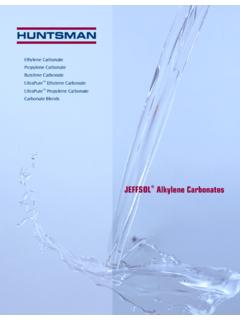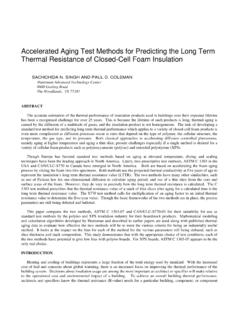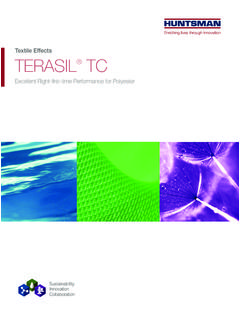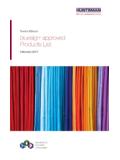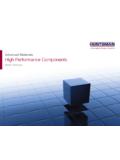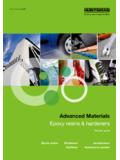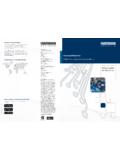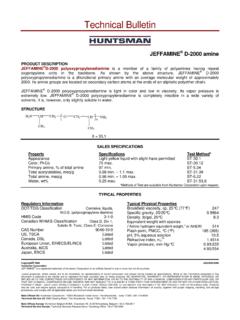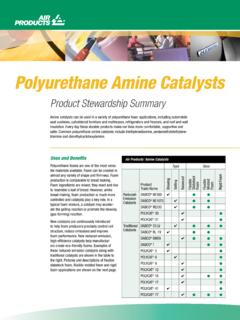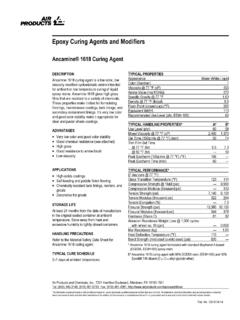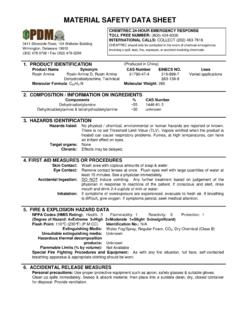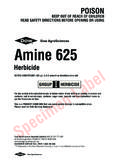Transcription of Epoxy Formulations Using JEFFAMINE® …
1 Epoxy Formulations Using jeffamine POLYETHERAMINES April 27, 2005 Authors: Bruce Burton David Alexander Howard Klein Angela Garibay-Vasquez Alan Pekarik Chris Henkee 1. Introduction Table of Contents 1. INTRODUCTION ..1 2. WHY jeffamine AMINE CURING AGENTS? ..2 3. CHARACTERISTICS OF THE jeffamine POLYETHEREAMINES (PEA s) ..3 4. jeffamine PEA AS Epoxy CURING AGENTS ..7 5. jeffamine PEA ACCELERATION OF CURE ..15 6. SURFACE COATING Formulations ..23 7. FLOORING, TROWELING AND MORTARS ..29 8. REINFORCED COMPOSITES ..37 9. CASTING AND 10. ADHESIVES ..42 11. CURED PROPERTIES REFERENCE GUIDE ..43 12. HANDLING AND 13. TOXICITY AND SAFETY ..58 14. SHIPPING INFORMATION ..59 15. HUNTSMAN CORPORATION PUBLICATIONS RELATING TO 16.
2 BIBLIOGRAPHY- jeffamine PEA APPLICATIONS ..61 1. Introduction 1 1. INTRODUCTION The jeffamine Polyetheramines (PEAs) described in this brochure are the result of years of research and development carried out since the 1960's by the Texaco Chemical Company. Development of new jeffamine polyetheramine products continues to be the focus of the Huntsman Corporation today. Because of their unique structure and variety of chemical reactions, these products have found their way into many different end uses. The purpose of this brochure is to present detailed technical formulation information primarily about four of the commercial jeffamine products: jeffamine D-230, D-400, D-2000, and T-403 amines, and to highlight their uses as curing agents for Epoxy resins.
3 Additional technical data on XTJ-504, XTJ-590, XTJ-506, HK-511 and BA-509 will also be highlighted. We believe that the information in this brochure is correct, but no guarantee with respect to accuracy, completeness, or results is expressed or implied. The end uses mentioned are given for purposes of illustration, and the systems outlined should be viewed as "starting Formulations " only. We urge you to conduct sufficient testing of any formulation before putting it into commercial use. We hope that you will find this information both interesting and useful. For the latest information on all jeffamine polyetheramine products, both commercial materials and those under development, contact one of our service locations listed on the inside of the back cover.
4 HUNTSMAN Your Amine Team Huntsman has provided over thirty years of service to the Epoxy industry. Huntsman invented and commercialized the jeffamine PEA amine curing agents. Huntsman provides the most extensive range of polyetheramines many which are unavailable anywhere else. Huntsman provides experienced technical support by virtue of having worked with these materials from their inception. If you have a problem, we likely have an answer. Huntsman s core competencies include alkoxylation and amination technologies, this means that the jeffamine amines are just part of a broad and diverse product portfolio. Huntsman produces the jeffamine amines in modern facilities located around the world.
5 Huntsman works with our customers to develop new and unique products. 2. Why jeffamine Amine Curing Agents 2 2. WHY jeffamine AMINE CURING AGENTS? The jeffamine amines, with their poly-ether containing backbone represent unique curing agents that result in properties that are often unobtainable with any other curing agents. The unique characteristics of the jeffamine amines include: WATER-WHITE IN COLOR: These make them ideal for use in decorative coatings and castings, as well as other applications requiring clarity and transparency. FLEXIBLE BACKBONE: The cured Epoxy will be somewhat flexible exhibiting high elongation, high impact strength and good low temperature properties. This is important in a variety of applications such as coatings that require chip resistance, coatings that are applied to materials of differing coefficient of expansion; or in composite/tooling applications where repetitive flexing or compression may be encountered.
6 LOW VISCOSITY: The low viscosities of these materials make them ideal in casting and self leveling applications. In addition, the low viscosities makes them the ideal to blend with other high-viscosity curing agents which otherwise could not be used. LOW VISCOSITY OFTEN TRANSLATES TO LOW CONTROLABLE REACTIVITY: The jeffamine amines product line spans the spectrum in terms of product reactivity. For example the slower hindered products allow for a moderate pot life, important in leveling and composite applications. In addition, the low exotherm of these slower materials allows the casting of larger and thicker parts. GOOD HEALTH & SAFETY PROFILE: Compared to many of the Epoxy hardeners currently used, the majority of the jeffamine amines are relatively innocuous and easy to handle.
7 jeffamine amine application advantages The above characteristics translate into specific advantages in a number of applications. For example, consider the following applications and the advantages of Using the jeffamine amine curing agents: Application Advantage of a jeffamine amine hardener Protective coatings -good wetting -low viscosity Formulations , allow for low VOC s and are easy to apply -flexibility upon cure, resists chipping and nicking -flexibility allows good performance when substrate expands/contracts due to temperature excursions (resists delamination) Decorative coatings -water white -good wetting -low viscosity means good flow and leveling -flexibility upon cure means flexible substrates can be coated Flooring -low viscosity means good self-leveling -low viscosity allows high loading -flexibility upon cure, resists chipping and nicking -good wetting means aggregates can easily be added Casting/Encapsulation -low viscosity allows good mold flow -good wet-out -moderate reactivity means large parts can be processed Composites -moderate pot life means long working time -flexibility means reduced cyclic micro-cracking -good wet-out of fibers 3.
8 Characteristics of the jeffamine Polyetheramines 3 3. CHARACTERISTICS OF THE jeffamine POLYETHEREAMINES (PEA s) CHEMICAL STRUCTURE The jeffamine PEA s make up a family of products having repeating polyether backbone structures. Four of the commercial products in the family contain repeating oxypropylene units. CH3 OCH2-CH The structures are functionally terminated with primary amine groups positioned on secondary carbon atoms. The basic polyetheramine frame structure is indicated below. By varying the X and R groups the jeffamine PEA series was developed. X R D-230 1-2 CH3 D-400 4-5 CH3 D-2000 32 CH3 HK-511 2 H XTJ-504 TEG H XTJ-590 EG H jeffamine T-403 and BA-509 are trifunctional (three amine groups per molecule) and can be represented by the following general formula.
9 Initiator Mw x+y+z T-403 TMP 400 BA-509 Glycerin 3000 49 The letter following the jeffamine trade name (D or T) represents the functionality (di- or tri-) of a given product, while the number designates the approximate average molecular weight. Thus, D-400 represents a diamine of about 400 molecular weight. BA-509 and HK-511 do not follow this convention. All XTJ-products indicate experimental jeffamine products, many of which have reached full commercial status. Note that the primary amine groups in these products are attached to secondary carbon atoms. Thus, the amine nitrogen is sterically hindered in nucleophilic reactions by the pendant methyl group.
10 The jeffamine PEA therefore exhibit "moderate" reactivity -- a desirable feature in many Epoxy applications. ~CH-NH2 CH3 (OCH2CH ) yNH2CH3 CH3 (CH2)n CH3 H2N ( CHCH2O ) xCH2 CCH2 zNH2R ( OCH2CH ) H2N CH3 R XCH2CH NH2CH3 CHCH2O ( H2 CHO ) 3. Characteristics of the jeffamine Polyetheramines 4 Table - Typical Physical Properties and Sales Specifications of jeffamine PEAs Typical Properties Test Method Property D-230 D-400 D-2000 T-403 XTJ-504 XTJ-590 XTJ-506 HK-511 BA-509 Color, Pt-Co 30 50 100 30 10 20 12 20 10 Brookfield viscosity, cps, 25oC (77oF)

